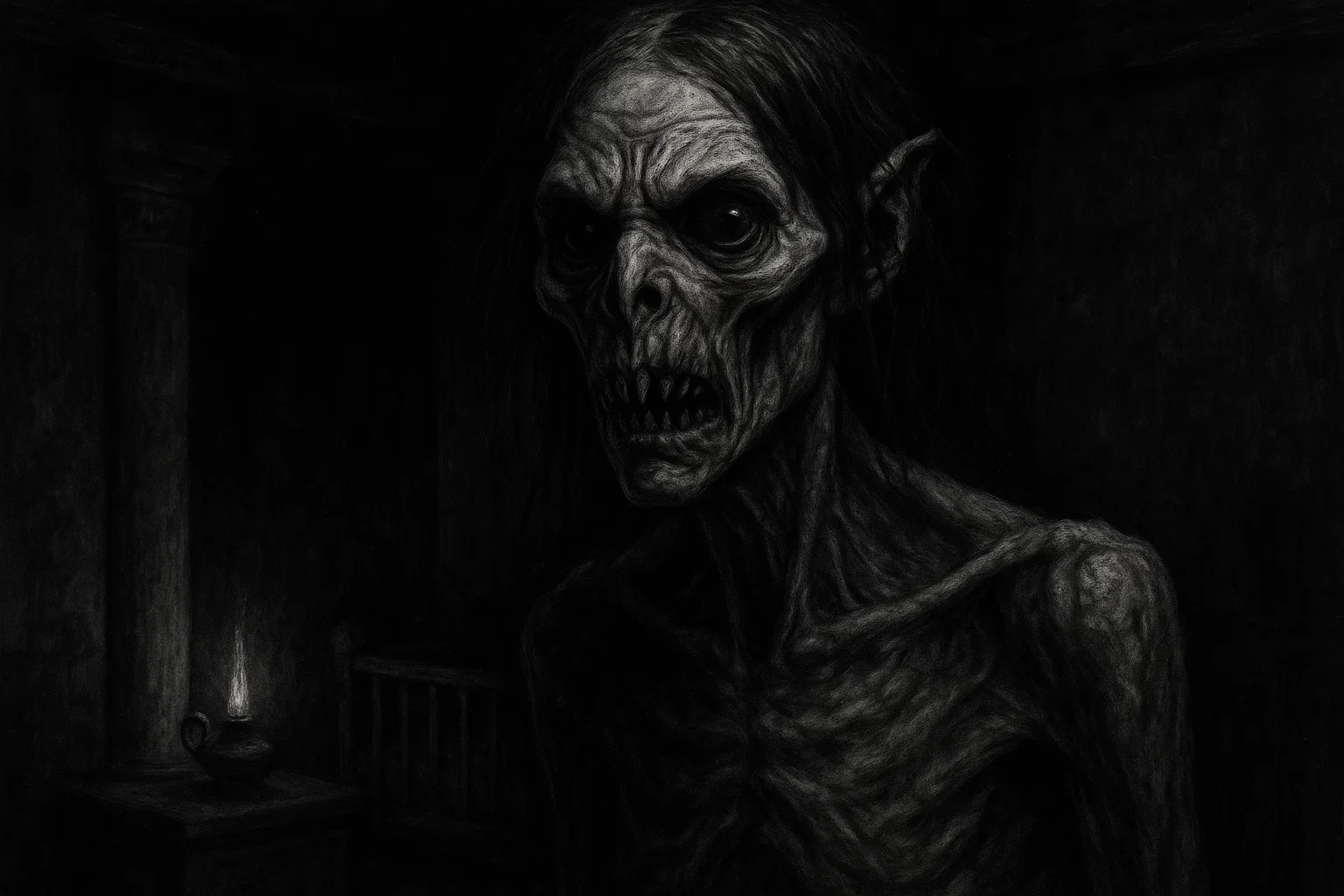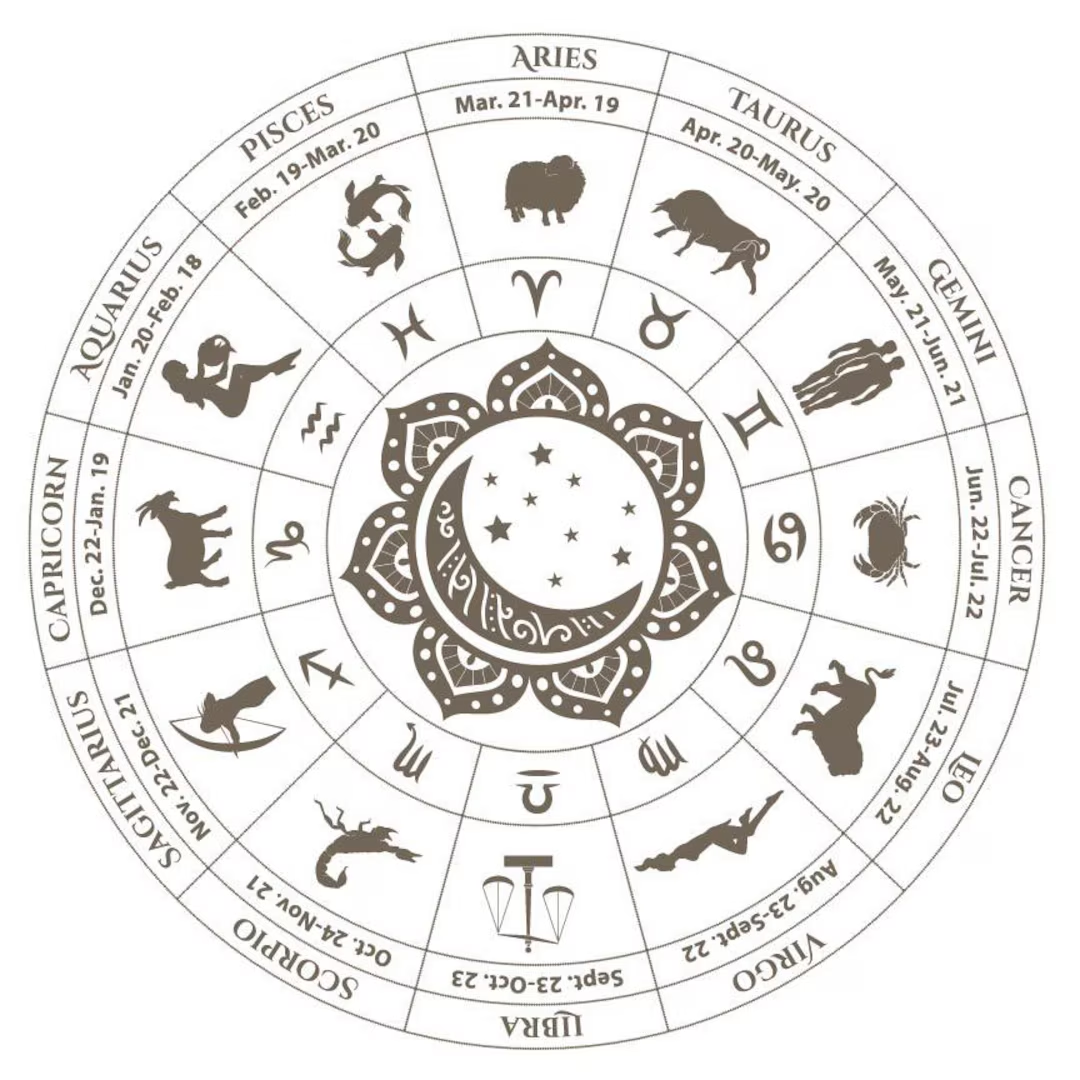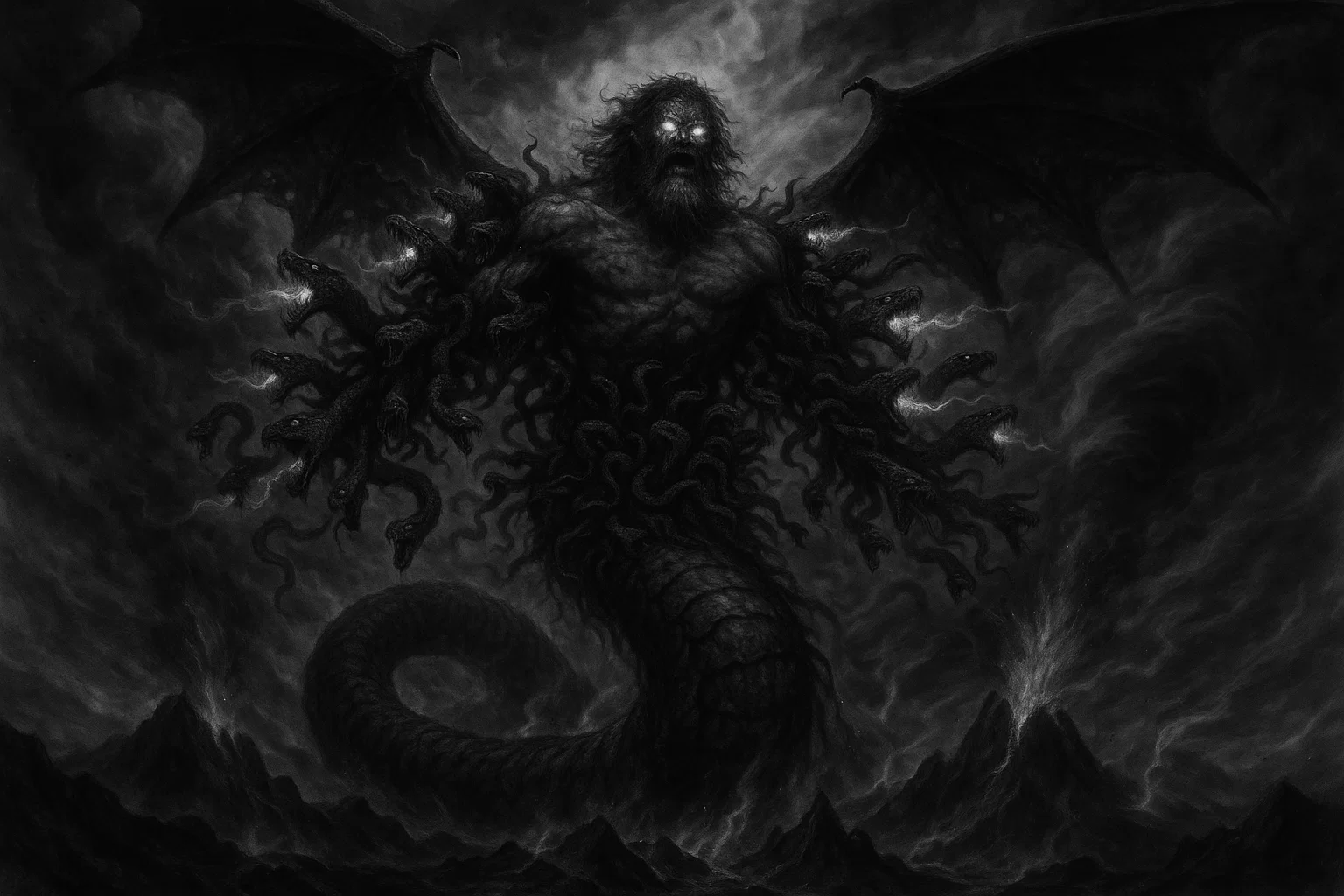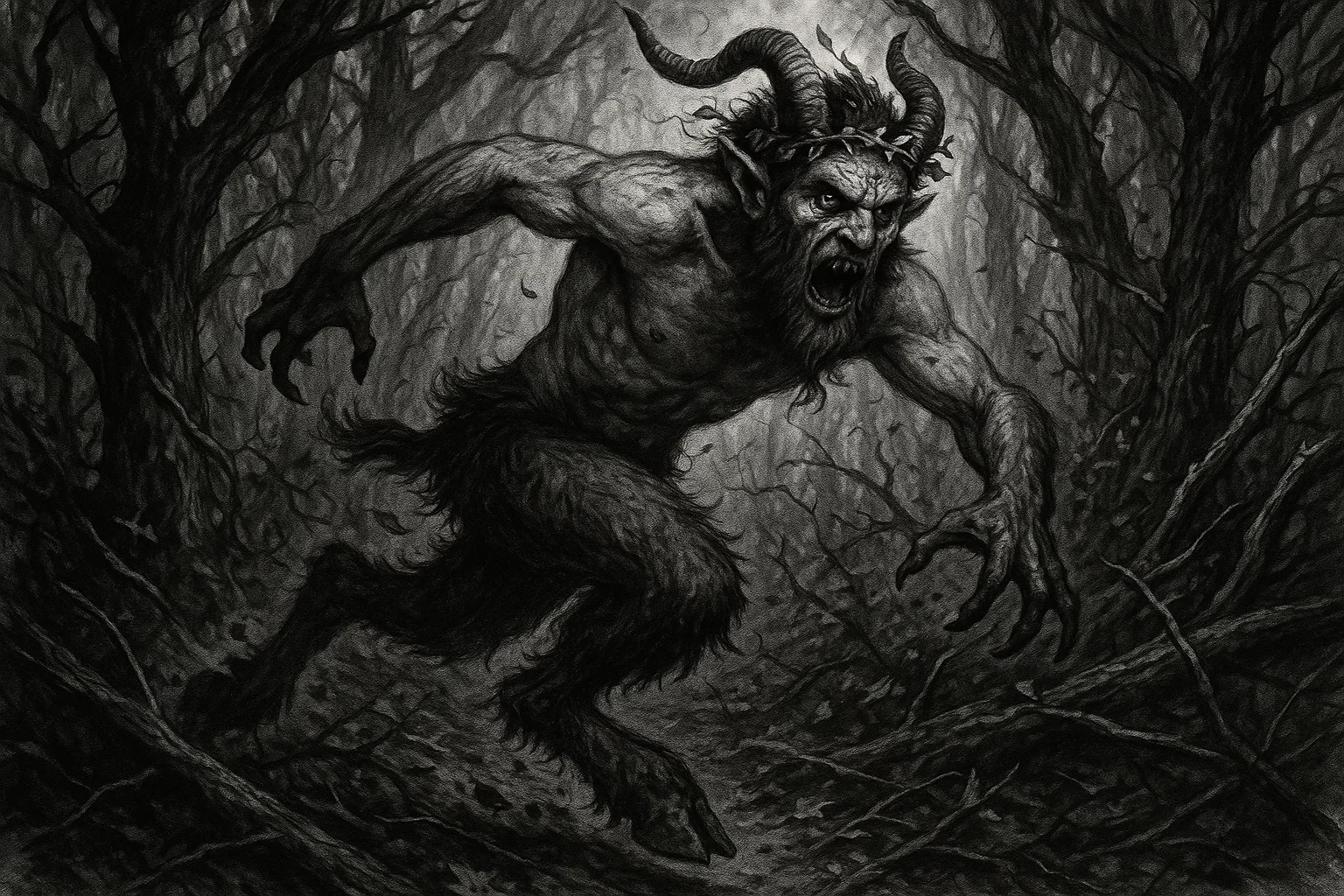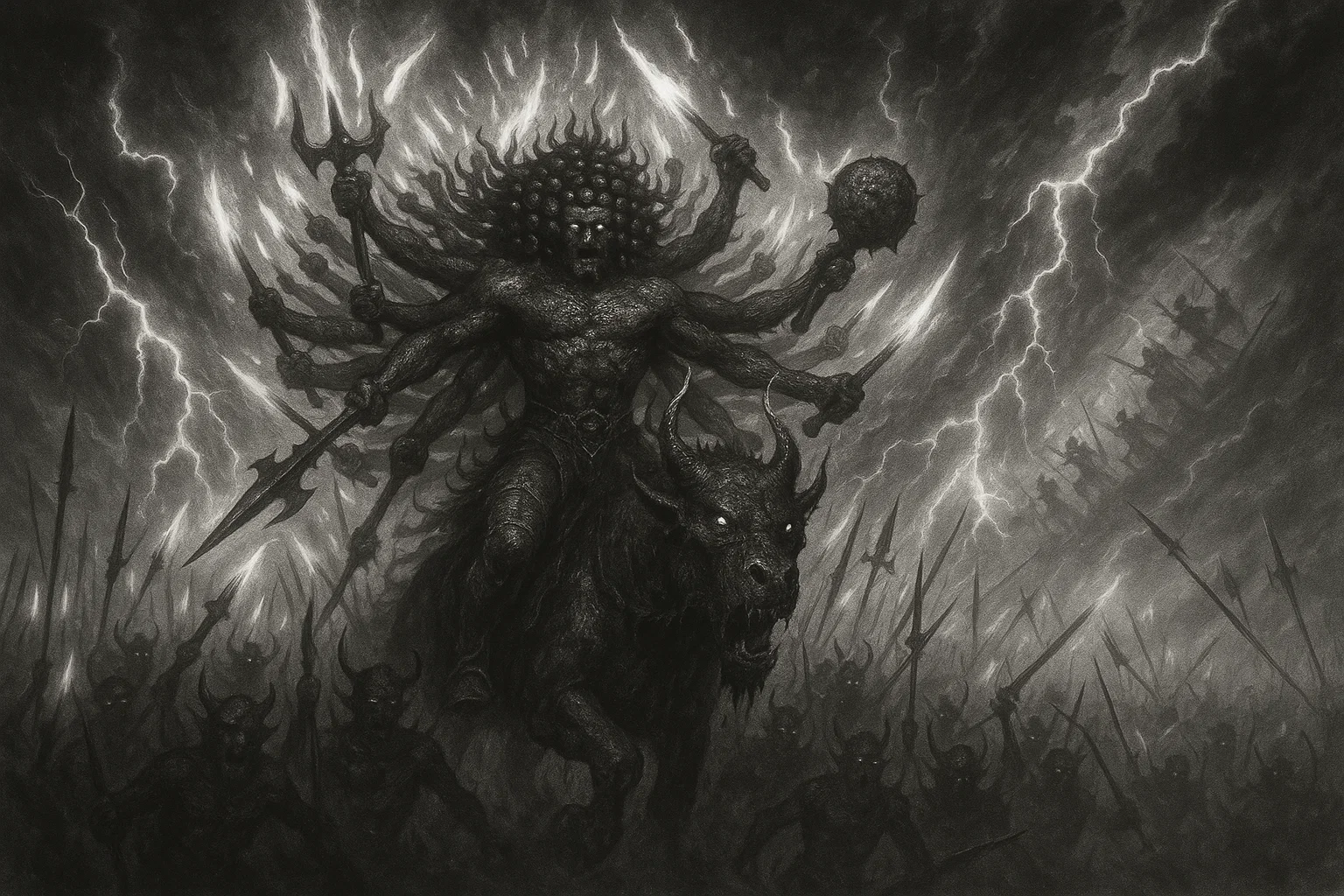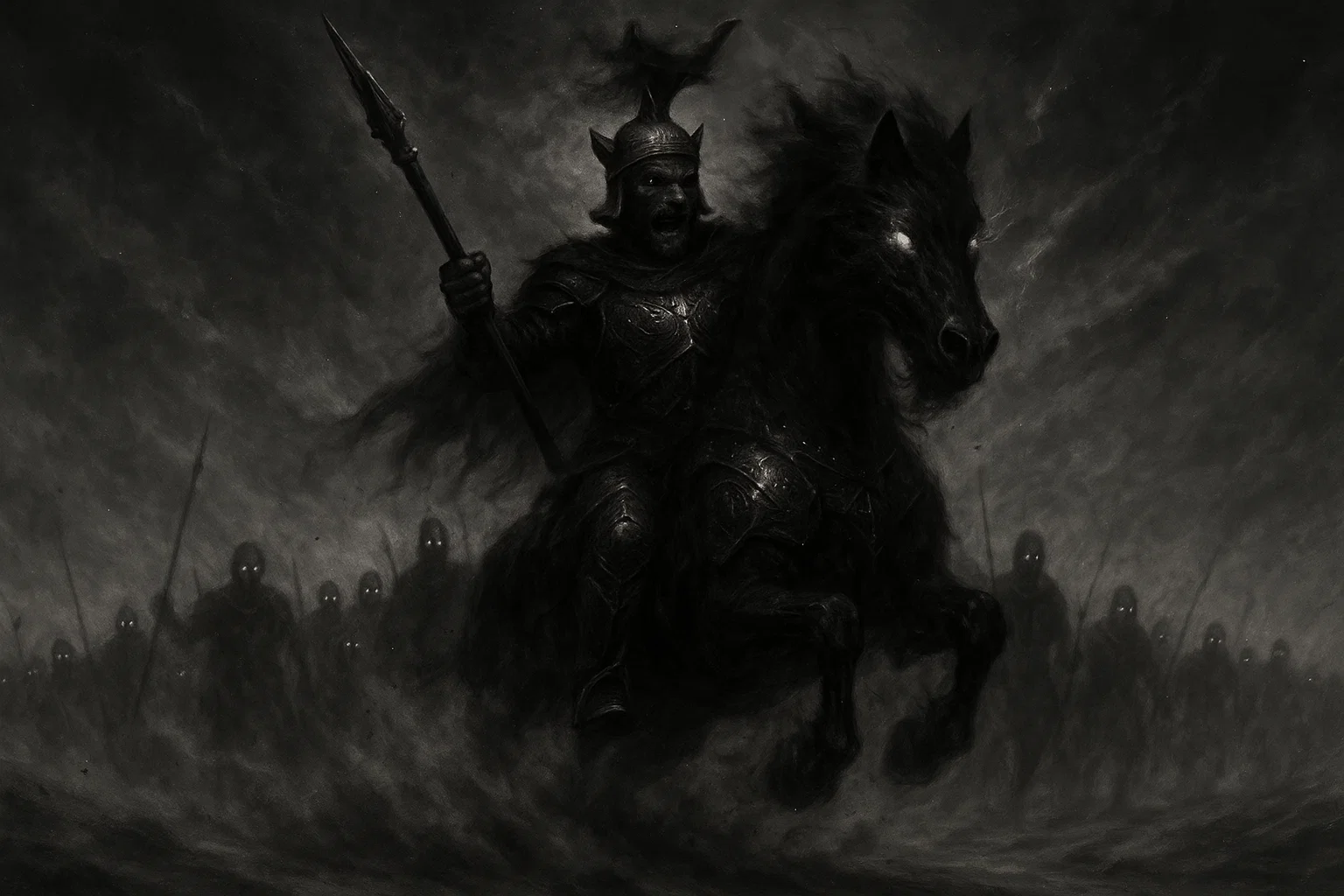Mormo, in ancient Greek folklore, is a female ghost or spirit, primarily known as a terrifying hobgoblin used to frighten disobedient children.
Often associated with the broader class of child-snatching demons (such as the Lamia and the Gello), Mormo served a significant pedagogical function in antiquity. Her name became synonymous with a frightening mask or a dreadful tale meant to enforce domestic obedience, particularly toward infants and young children.
The creature’s depiction is generally consistent across sources, portraying her as an emaciated, hideous spirit with monstrous features. While later traditions sometimes conflated her with the Empusa or the Lamia—both blood-drinking female entities—Mormo’s primary and most enduring role in early Greek life was as a nursery bogy, a being invoked to prevent children from crying or misbehaving.
Summary
Key Takeaways
| Attribute | Details |
| Names | Mormo (Μορμώ); Mormolyke (Μορμολύκη), sometimes used interchangeably; possibly linked to the root μoρμώ meaning ‘fear’ or ‘terror’. |
| Nature | Spectral entity, spirit, or demon (daemon). |
| Species | Female humanoid spectral being. |
| Appearance | Hideous, grotesque, and emaciated female phantom. |
| Area | Ancient Greece, particularly associated with household and nursery settings. |
| Creation | Lore is inconsistent; often categorized as a type of ghost or minor underworld spirit rather than a specific origin event. |
| Weaknesses | Avoided by well-behaved children; repelled by noise or light (implied, not explicitly stated). |
| First Known | 5th century BCE, attested in the fragments of the playwright Aristophanes. |
| Myth Origin | Ancient Greek folklore and oral tradition, predating formalized written mythology. |
| Diet | Child consumption/abduction (often used as a threat). |
| Time Active | Nocturnal, but can be invoked at any time as a threat. |
Who or What Is Mormo?
Mormo is an ancient Greek wraith, a terrifying female monster whose existence is mainly attested through her role as a bogy—a creature invoked by adults to frighten and control children. She belongs to a group of chthonic or nocturnal female demons like Lamia and Empusa, who were believed to pose a threat to infants and young women, often in the context of child-abduction or feeding on vitality.
However, unlike Lamia, whose legend often carries a tragic backstory of a wronged queen, Mormo’s identity is more purely symbolic, representing pure, unadulterated fear.
The term Mormo was often used metaphorically in common speech. To call someone a “Mormo” meant they were ugly or monstrous. The term Mormolyke (Mormo-wolf) was a related epithet that emphasized her savage or predatory nature.
Aristophanes’ use of the name in his comedies confirms that by the 5th century BCE, Mormo was already a widely recognized figure in Athenian society, understood primarily as a monstrous presence existing on the fringes of the domestic sphere, ready to snatch or devour the unruly or unprotected child.
Your Personalized, Hyper Accurate Moon & Astrology Reading
Limited time offer: Get your FREE, fully personalized Moon & Astrology Reading that takes astrology to a whole new level. Discover the secret depths of your personality, relationships, and true purpose in life.
Genealogy
Mormo’s genealogy is not documented in classical mythology. She is generally considered a minor independent spirit or specter rather than a goddess, titan, or the offspring of known deities.
Etymology
The name Mormo (Μορμώ) is generally derived from the Greek verb μορμω, which means “to terrify,” “to scare,” or “to threaten.” It is directly linked to the concept of a “bogey” or “frightening mask.” Therefore, her name is inherently descriptive of her function: the embodiment of terror used in a pedagogical context.
The root of the word is associated with other related terms, such as mormo-lyke (Μορμολύκη), which translates as “Mormo-wolf” or a monstrous creature akin to a wolf, emphasizing a savage, devouring quality. The suffix λυκη (lyke or lykos), meaning ‘wolf’, suggests a convergence with the idea of a predatory beast.
Early mentions of Mormo, particularly by Aristophanes, indicate the word was already in common use by the Classical period (5th-4th centuries BCE) as both a proper name for the specter and a general term of reproach for anything hideous, ugly, or frightening.
The linguistic evidence suggests that Mormo did not appear from a specific, formalized theological mythos but rather developed organically within Greek household language and oral traditions—a name invented to categorize and leverage the natural fears of children.
You May Also Like: What Is a Harpy, The Winged Horror That Tormented Kings?
What Does Mormo Look Like?
Descriptions of Mormo focus on her monstrous, repellent characteristics, designed to elicit immediate fear. She is consistently depicted as a vile, emaciated female phantom or crone.
While specific, detailed accounts of her appearance are sparse, she is universally understood to be ugly and grotesque. The poet Theocritus mentions that Mormo was a sight of horror to children. The related name Mormolyke suggests a wolf-like savagery or a hideous, bestial face.
In a general sense, she is often imagined as having an intimidatingly ugly countenance, perhaps with disproportionate features, a gaunt, withered body, and the ability to shift her form to appear most terrifying.
However, this ability is often conflated with that of her sister-entities, the Empusa and the Lamia. Her appearance is essentially a physical manifestation of the terror she is meant to embody.
Mythology
Mormo’s mythology is fragmentary and exists primarily outside the scope of major Olympian narratives, residing instead in the realm of domestic and folk belief. She is categorized as a type of daemon or spirit whose primary function is to punish or abduct children who fail to adhere to household rules.
The earliest known mention of Mormo appears in the works of the Athenian comedic playwright Aristophanes in the 5th century BCE. In his play Acharnians, the term Mormo is used as an exclamation of fear or a metaphor for something horrible.
This early and casual reference confirms that Mormo was an established household bogey well before Aristophanes’ time, familiar to the general Athenian audience.
She is often discussed alongside the Lamia and the Empusa, as the three form a classical triad of female child-snatching specters. The Empusa, a bronze-footed daughter of Hecate, and the Lamia, a Libyan queen transformed into a child-devouring monster, both have clearer mythic origins.
Mormo, however, lacks a specific transformation myth or family lineage, suggesting she is a more elemental representation of fear rather than a figure derived from tragedy or divine punishment.
The most enduring aspect of her mythology is her use as a pedagogical threat. Ancient Greek and Roman writers, including Strabo and later Plutarch, mention that the name Mormo (or similar entities such as Lamia) was used to silence crying infants or deter children from entering dangerous places.
Her simple, terrifying function in Greek life ensured her longevity as a folkloric entity, persisting in oral tradition long after the formal worship of the Olympians waned. She embodies the basic parental fear of losing a child and the need for behavioral control through manufactured dread.
You May Also Like: 10 Short Horror Stories You Should Never Read Alone
Legends
Mormo is unique in classical folklore in that no lengthy, cohesive narrative myths or epic legends are dedicated to her. She is not the subject of major poetic works or dramatic cycles. Still, she is rather a cultural reference point and a cautionary figure.
Her existence is primarily documented through brief references, proverbs, and allusions in the works of various authors, confirming her role in folk belief and daily life.
Awaken XT is unlike anything you’ve ever tried before…
…it’s based off a closely guarded formula that’s said to be able to supercharge your pineal gland and help you access your untapped inner power. With it’s unique blend of extremely hard to source ingredients, Awaken XT helps support the healthy functioning of your pineal gland, as well as your other organs in your body.
The Mormo as a Nursery Bogy
The core “legend” of Mormo is her function as the quintessential nursery bogy across the Greek world. She was the spectral entity whom mothers and nurses would invoke to frighten and control infants and toddlers.
For instance, if a child was crying uncontrollably, the caregiver might threaten, “Be quiet, or Mormo will come and take you away!” This threat was instantly recognizable and often effective because Mormo represented the ultimate, unseen danger lurking outside the domestic sanctuary.
Her terror was not predicated on a complex history, but on the simple, visceral threat of abduction and consumption. Her lack of a formal, written legend suggests her story was a vital part of oral culture, passed down as a simple, powerful tool of domestic discipline.
The Allusion in Aristophanes
One of the earliest and most instructive literary appearances of Mormo is in Aristophanes’ play Acharnians (425 BCE). The character of Lamachus, a boastful and warlike figure, is described in a manner that reveals Mormo’s cultural standing.
When Dicaeopolis, the peace-loving protagonist, mocks Lamachus’s elaborate military gear, he suggests that Lamachus is so frightening he looks like the Mormo, implying the warrior’s appearance is grotesque and artificially terrifying, like a scary mask used to ward off evil or frighten children.
The audience’s immediate understanding of this insult confirms that Mormo was a well-established, universally understood symbol of sheer ugliness and manufactured horror in Classical Athens. The humor relies entirely on the audience recognizing her as the embodiment of the ridiculous yet frightening figure.
You May Also Like: The Demon Div: The Terrifying Horned Demon of Chaos
Mormo and the Empusa
In later Hellenistic and Roman periods, Mormo’s name was often conflated with or used as a substitute for other child-snatching entities, notably the Empusa.
The Empusa was a terrifying ghoul, a daughter of the goddess Hecate, known for her ability to shape-shift and seduce men before devouring them or drinking their blood. Some sources used the name Mormo as a generic term for any frightening, dreadful female spirit, blurring the lines between the entities.
For example, some stories that may originally have featured the Empusa’s form-changing abilities and predatory nature were occasionally attributed to Mormo, suggesting that Mormo persisted more as a generic archetype of the female monster than as a distinct entity with fixed narratives.
Mormo vs Other Monsters
Mormo is part of a broad international category of child-snatching hags and specters. Her closest parallels are found within Greek mythology itself and in the folklore of neighboring regions.
| Monster Name | Origin | Key Traits | Weaknesses |
| Lamia | Greek Mythology | A former queen transformed into a serpent-like monster; feeds on children and men. | Losing her eyes (which she can remove) weakens her ability to see and hunt. |
| Empusa | Greek Mythology | Daughter of Hecate; bronze leg and donkey leg; shape-shifts to seduce men and drink their blood. | Can be driven away by curses and insults; possibly driven away by light. |
| Gello | Greek Mythology | Female demon/ghost; causes infant mortality and infertility; similar to Lamia. | Amulets and rituals used for protection, especially for new mothers. |
| Striga | Greco-Roman Mythology | A nocturnal bird/hag that feeds on human flesh and blood (later evolved into the Strix). | Specific herbs, garlic, and bright light (implied). |
| Lilith | Jewish/Mesopotamian Folklore | First wife of Adam; abducts infants and torments women in childbirth. | Amulets bearing the names of three protective angels (Senoy, Sansenoy, Semangelof). |
| Baba Yaga | Slavic Folklore | A terrifying witch who lives in a house on chicken legs; sometimes a child-eater. | Fire, specific magical items, and a pure heart (in some tales). |
| La Llorona | Latin American Folklore | The weeping woman; ghost of a mother who drowned her children, now searches for them and frightens/snatches others. | Her spirit is tied to the place of her tragedy; avoidance. |
| Jibba | Ancient Arabian Folklore | A type of female ghoul or demon that preys on travelers or children. | Prayer, iron, or the ability to outwit her. |
Mormo belongs to the widespread ancient archetype of the “child-devouring female daemon.” Her primary similarities with the Lamia and Empusa are profound, to the point where they are often used interchangeably, all three serving as bogies to enforce domestic order.
Like the Gello and Lilith, her terror is targeted directly at the vulnerability of infants and the domestic sphere, making her a nightmare for new mothers. Mormo’s distinction lies in her purity of function: she is almost exclusively the embodiment of the scaring threat itself, unlike the Lamia (who has a tragic past) or the Empusa (who has connections to Hecate and seduction).
Mormo’s existence is less about a detailed narrative and more about a psychological tool. The weaknesses attributed to her are less ritualistic than those of Lilith or the Empusa, relying instead on the simple cessation of the child’s misbehavior, which removes the need for her invocation.
You May Also Like: Who Is Cimejes, the Twentieth Demon in the Ars Goetia?
Powers and Abilities
Mormo’s powers are primarily rooted in her terrifying appearance and supernatural presence rather than complex magical spells. Her existence is predicated on her ability to instill extreme fear in her target, particularly young, impressionable children.
Her most significant power is the ability to act as a disembodied spectral threat, allowing her to be anywhere at any time in the minds of the children she is invoked against. This ubiquitous presence makes her an effective tool of domestic control.
Furthermore, given her frequent conflation with the Empusa, she is often implied to possess shapeshifting capabilities, enabling her to appear as a hideous phantom, or perhaps even a more subtle, predatory figure (the Mormolyke or “Mormo-wolf” aspect).
The overarching ability is the psychological terror she imposes, which is her true function in the mythology.
Her powers and abilities include:
- Spectral Intimidation: The ability to manifest as a grotesque, hideous phantom to immediately frighten and silence children.
- Child Abduction/Consumption: The purported power to snatch and devour misbehaving or unprotected infants, a threat central to her folklore function.
- Transformation: The potential, often borrowed from the Empusa or Lamia, to alter her form into something frightening or predatory, reflecting her Mormolyke epithet.
Can You Defeat a Mormo?
Given Mormo’s primary existence as a bogey or a rhetorical figure of fear, explicit methods for her physical defeat are rarely documented in ancient sources. Her “defeat” is often achieved simply by removing the psychological necessity of her presence.
In the nursery, the most effective “defense” is for the child to stop the misbehavior—to stop crying, go to sleep, or obey the caregiver. The threat of Mormo is thus neutralized because the conditions for her arrival (an unruly child) have been removed.
However, based on her similarity to other chthonic specters, the following methods are generally implied or used against similar creatures:
- Verbal Repulsion: Entities like the Empusa were known to be driven off by curses and insults hurled by mortals. A bold denunciation or insult against the hideous Mormo might be an effective deterrent.
- Vigilance and Protection: As a creature that preys on the vulnerable (infants), keeping watch over children and using general protective measures common in Greek households (like amulets or the burning of certain incense) would be expected to ward her off.
- Avoidance of Her Name: Some folk beliefs suggest that uttering the name of a daemon or specter gives it power. Therefore, avoiding invoking the name Mormo unless actively intending to use her threat is a form of protection. Ultimately, she is best defeated by maturity and disbelief, as a child grows out of the fear and the threat loses its power.
You May Also Like: What Is a Centaur? The Greek Monsters Born from Sin
Conclusion
Mormo is a quintessential figure in ancient Greek domestic folklore, her name less attached to epic narrative and more to the quotidian management of childhood. She is not a deity or a hero’s foe, but the embodiment of the bogey, a powerful, concise verbal tool used by adults to maintain order. Her identity is intimately tied to the root meaning of her name: terror.
The endurance of Mormo and similar specters, such as Lamia, across centuries highlights the universal human need to personify danger and the effectiveness of fear as a pedagogical instrument.
While later traditions often conflated her with more detailed monsters, Mormo’s purest form remains that of the unseen, hideous female specter ready to snatch the disobedient.
Her story is a testament to the power of oral tradition and the way folk belief utilizes simple, potent images to navigate the complex anxieties surrounding child safety and discipline in the ancient world.

